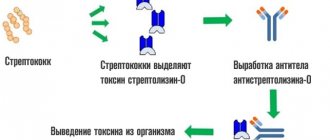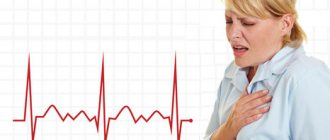From this article you will learn what EOS is and what it should be normally. When the EOS is deviated slightly to the left - what does this mean, what diseases can it indicate. What treatment may be required.
Author of the article: Victoria Stoyanova, category 2 doctor, head of the laboratory at the diagnostic and treatment center (2015–2016).
Article publication date: 05/14/2017
Article updated date: 02/05/2020
The electrical axis of the heart is a diagnostic criterion that reflects the electrical activity of the organ.
The electrical activity of the heart is recorded using an ECG. Sensors are placed on different areas of the chest, and to find out the direction of the electrical axis, it (the chest) can be represented as a three-dimensional coordinate system.
The direction of the electrical axis is calculated by the cardiologist during the interpretation of the ECG. To do this, he sums the values of the Q, R and S waves in lead 1, then finds the sum of the values of the Q, R and S waves in lead 3. Next, it takes the two obtained numbers and calculates the alpha angle using a special table. It's called the Diede table. This angle is the criterion by which it is determined whether the location of the electrical axis of the heart is normal.
EOS offsets
The presence of a significant deviation of the EOS to the left or right is a sign of cardiac dysfunction. Diseases that provoke EOS deviation almost always require treatment. After getting rid of the underlying disease, the EOS takes a more natural position, but sometimes it is impossible to completely cure the disease.
To resolve this problem, consult a cardiologist.
What is EOS?
When deciphering an electrocardiogram, one of the parameters is the EOS - the electrical axis of the heart. This indicator indirectly reflects the position of this organ in the chest.
The atria and ventricles of the heart are controlled by impulses that travel through the conduction system. When taking a cardiogram, electrical signals passing inside the heart muscle are recorded.
For ease of measurement, the heart is schematically represented as a three-dimensional coordinate axis.
When added together, the pulses form a directed electric vector. It is projected onto the frontal vertical plane. This is EOS. Usually the electrical axis coincides with the anatomical one.
Effect of direction of ventricular depolarization
It can be confirmed in case of incomplete blockade of the anterior branch of the left ventricle, when the propagation of impulses along the upper left parts of the left ventricle is impaired and the average electrical axis of the QRS complex is deviated to the left (see section “Impaired intraventricular conduction”). On the contrary, with pancreatic hypertrophy it is deviated to the right.
What should its normal position be?
The anatomical structure of the heart is such that its left ventricle weighs more than the right. Therefore, the electrical excitation on the left side of the organ is stronger.
Graphically, this is expressed in the fact that the axis is directed diagonally to the left and down. If you look at the vector projection, the left side of the heart is located in the area from +30 to +70 degrees. This is the normal value for an adult.
The position of the axis also depends on the individual characteristics of physiology.
The direction of EOS is influenced by the following factors:
- Pulse speed.
- The ability of the heart muscle to contract.
- Features of the structure of the spine, chest, internal organs that interact with the heart.
Taking these factors into account, the normal axis value ranges from 0 to +90 degrees.
In a healthy person, the EOS can be in one of the following positions:
- Normal - the angle of deviation from the coordinate axis is from +30 to +70 degrees.
- Intermediate - from +15 to +60.
- Vertical - between +70 and +90. This is typical for thin people with a narrow chest.
- Horizontal - from 0 to + 30 degrees. It occurs in people with a wide chest and short stature.
In newborns, deviation of the EOS to the right is often observed. By one or two years, she moves to a vertical position. After children reach the age of three, the axis usually returns to its normal position.
This is due to the growth of the heart, in particular, with an increase in the mass of the left ventricle.
General information about pathology
The electrical activity of the body's motors is recorded using an ECG.
To imagine what the heart axis is, it is necessary to construct a coordinate scale and mark the directions in increments of 300. The semi-vertical position of the organ in the chest when superimposed on the coordinate system sets the electrical axis. Vectors make an angle, so the direction of the EOS is measured in degrees from -180 to +1800. With a normal location, it should be within +30 – +69.
If, under the influence of any factors, a change in the position of the organ and the vector of signal transmission occurs, then they speak of its change in the coordinate system.
Normally, the heart has a sinus rhythm, the electrical impulse begins from the atrium and then moves to the ventricles. On an electrocardiogram, the normal position of the organ can be determined if the P wave is detected, indicating atrial contraction, the QRS complex, contraction of the ventricles and T, their repolarization.
The location of the terminals when taking an ECG is the direction of the electrical impulse of the heart. When removing the leads, 3 main and 3 auxiliary lines are determined, as well as chest indicators .
We can talk about a normal axis value if the R wave has the greatest value in the 2nd main lead, and the value is R1>R3.
If there is a shift in the electrical axis to the left, what does this mean? There are factors that cause the organ to preponderate to the left. A leftogram is observed if the axis position is from 0 to -900.
What could cause it to shift to the right?
A sharp deviation of the electrical vector from its axis is sometimes caused by processes occurring inside the body (pregnancy, development of tumors, etc.).
However, most often this means the presence of disturbances in the functioning of the heart muscle.
An axis shift can occur for the following pathological reasons:
- Ischemic disease. Blockage of the arteries that provide blood supply to the myocardium develops.
- Impaired blood flow in the branches of the pulmonary artery. Occurs as a result of vasoconstriction, which causes pressure in the right side of the heart to increase.
- Myocardial infarction. Against the background of ischemic disease, tissue necrosis develops due to insufficient blood supply.
- The opening between the left atrium and the ventricle narrows (stenosis), which leads to significant tension in the right side of the organ and its subsequent hypertrophy.
- Blockage of the pulmonary artery (thrombosis).
- Arrhythmia is a heartbeat disorder accompanied by chaotic excitation of the atria.
- The occurrence of chronic pulmonary pathology in which hypertrophy of the right atrium and ventricle is observed. In medicine, this disease is called “cor pulmonale.”
- Abnormal development of the myocardium, in which there is a displacement of the organ to the right side. At the same time, the electrical axis also deviates.
A shift of the axis to the right is also observed due to long-term use of tricyclic antidepressants, resulting in severe intoxication of the body. This negatively affects the functioning of the heart.
When the EOS is deviated to the right side in newborns, this is considered normal.
However, if the shift is associated with a blockade of the bundle branches (impaired passage of electrical impulses through the bundles of heart cells), then an additional examination of the baby is performed.
Cardiac pathologies can be congenital or acquired during life, which develop as a result of previous serious illnesses or due to increased physical activity.
For example, professional athletes are often diagnosed with an increase in the mass and volume of the left ventricle (hypertrophy).
ECG interpretation
Interpretation of ECG results in a child: norms of indicators and causes of violations
Electrocardiography (ECG) is a fast and high-quality way to obtain information about the functioning of the heart.
Often, such an examination is prescribed to children to identify a particular heart disease. It has some differences from the ECG of an adult. Parents of babies should know what this procedure is, how to properly prepare their child for it, and how the cardiogram results are interpreted. In what cases is an ECG prescribed for a child?
The pediatrician prescribes an ECG for children in certain cases. These include:
- heart murmurs;
- dizziness;
- headaches and fainting;
- fast fatiguability;
- pain in the chest area;
- swelling of the limbs;
- frequent infectious diseases;
- preparation for surgery;
- hereditary predisposition to cardiovascular pathologies;
- high pressure;
- endocrine system disorders;
- slow physical development.
Children are also given an ECG before being discharged from the maternity hospital to exclude heart defects and during a routine medical examination before entering kindergarten or school. A cardiac examination is also indicated before starting sports.
Features of the child’s body that should be taken into account during an ECG
The work of the heart in young children has its own characteristics. Compared to the heartbeat of adults, it is much faster in babies. For clarity, below is a table of normal heart rate indicators depending on a person’s age:
| Age | Normal heart rate, beats per minute | Average heart rate, beats per minute |
| 0-1 month | 110-170 | 140 |
| 1-12 months | 102-162 | 132 |
| 1-2 years | 94-154 | 124 |
| 2-4 years | 90-140 | 115 |
| 4-6 years | 86-126 | 106 |
| 6-8 years | 78-118 | 98 |
| 8-10 years | 68-108 | 88 |
| 10-12 years | 60-100 | 80 |
| 12-15 years | 55-95 | 75 |
| 15-50 years | 60-80 | 70 |
| 50-60 years | 64-84 | 74 |
| 60-80 years | 69-89 | 79 |
An ECG in the first year of life does not allow doctors to miss a congenital defect or other heart disease
ECG readings in newborns, infants, and adolescents often differ from normal values. When making a diagnosis, the doctor takes into account the deviations acceptable for each age group. Also, during the procedure, some features of the child’s body are taken into account:
- in infants the right ventricle often predominates, which is not a pathology; this discrepancy disappears with age;
- the younger the child, the shorter the cardiogram intervals;
- the size of the atrium in children is larger than in adults;
- the T wave on the graph of electrical signals from the heart muscle has a negative value;
- rhythm sources migrate within the atria;
- alternans of teeth on the ventricular complex;
- the likelihood of incomplete blockade on the right bundle branch;
- respiratory and sinus arrhythmia;
- possible occurrence of a deep Q wave in the 3rd standard lead.
Norms and interpretation of ECG indicators for children of different ages
The diagnosis is made taking into account indicators such as teeth, segments and intervals. Their presence or absence, height, location, duration, sequence and direction are taken into account.
Heart problems are identified by analyzing the following data:
- Sinus rhythm. This is the rhythmic contraction of the heart muscle under the influence of the sinus node. This indicator allows you to evaluate the nature of contractions of the ventricles and atria.
- Heart rate in children of different ages.
- Source of excitation. It is determined by examining the P wave.
- Cardiac conduction.
- Electric axis. In leads 1 and 3, the Q, R and S waves are analyzed, which makes it possible to evaluate the functioning of the His bundle.
Only an experienced specialist should interpret the results of the electrocardiogram.
Interpretation of ECG results is carried out by a competent cardiologist who knows the specifics of the functioning of the heart in each age group. On the cardiogram, the processes occurring in the heart muscle are indicated by capital letters of the Latin alphabet - P, Q, R, S, T. Each designation on the diagram indicates certain processes:
- ventricular relaxation - T;
- contraction and relaxation of the atria - P;
- excitation of the septum between the ventricles – Q, S;
- ventricular excitation – R;
- duration of passage of an electrical impulse from the atria to the ventricles - PQ;
- relaxation of the heart muscle in the interval between contractions - TP;
- peak excitation of the ventricle – ST;
- the duration of its contraction is QRST.
The psycho-emotional state of the child can negatively affect the accuracy of ECG readings
ECG results can be affected by factors such as the time of day, the psycho-emotional state of a small patient, food intake, incorrect application or displacement of electrodes, and interference from operating foreign devices. The following indicators are normal for a child:
- for QRS – 0.06–0.1 s;
- for P – ≤ 0.1 s;
- for PQ – 0.2 s;
- for QT – ≤ 0.4 s.
ECG results often indicate a poor cardiogram with deviations from the norm. In this case, if necessary, the child is prescribed an additional examination, and then the optimal treatment method is selected.
Possible causes of rhythm disturbances and other parameters on the ECG in a child
Electrocardiography in children often reveals heart rhythm disturbances. The causes of disorders are divided into cardiac and extracardiac. The first type of factors provoking arrhythmia include:
- birth defects;
- autoimmune and other pathologies of the heart;
- heart tumors and injuries;
- severe infectious diseases;
- anomaly of organ development;
- carrying out probing and contrast X-ray examination of blood vessels.
ECG allows timely detection of heart rhythm disturbances
Extracardiac causes of arrhythmia are pathologies of the nervous and endocrine systems, blood diseases, and premature birth. Intense exercise also makes the heart rhythm irregular. Along with this, high air temperature, emotional stress and the simultaneous course of heart disease and failure of the neurohumoral regulation of the heart can provoke arrhythmia.
Electrocardiography often records tachycardia (we recommend reading: how does sinus tachycardia manifest itself in children on an ECG?). The cardiac causes of the disease are similar to the factors that provoke the development of arrhythmia. Extracardiac sources of the disease include:
- acidosis;
- low blood sugar levels and disturbances in its electrolyte composition (we recommend reading: what is the normal blood sugar level for a 12-year-old child?);
- diseases of the endocrine system;
- tonsillitis and conditions arising after a sore throat;
- neurotoxicosis;
- intoxication syndrome with elevated temperature;
- side effects of a number of medications.
In accordance with the ECG results, the pediatric cardiologist prescribes the necessary treatment
An ECG can detect bradycardia. Among the most common causes of the disease are:
- disruption of the nervous and endocrine systems;
- high intracranial pressure;
- diagnosis of hypoxia at birth and a tendency to bradycardia during pregnancy;
- infectious diseases;
- severe hypothermia;
- large dosages of potent medications or their prolonged use;
- rapid growth of internal organs;
- circulatory disorders in the brain;
- malfunction of the thyroid gland.
Often, a child’s heart rate deviates from the norm after a strong fright, holding his breath for a long time and under the influence of vivid emotions and events experienced during the day. These phenomena are temporary and do not indicate pathology.
Heart diseases in children that can be detected by taking an ECG
Based on the cardiogram indicators, the doctor can determine this or that disease in the child.
Heart rhythm disturbances
In medical practice, this condition is called extrasystole. In this case, the patient periodically feels an increase in heart rate with its subsequent freezing. Extraordinary contraction is caused by impaired conduction of cardiac impulses.
In rare cases of arrhythmia attacks, there is no danger to health. Attention should be paid to regularly recurring disturbances in heart rhythm, accompanied by shortness of breath, pain and other negative symptoms.
Arrhythmia
With this pathology, changes in the periodicity of sinus rhythm occur, while the arrival of cardiac impulses occurs at different frequencies. Arrhythmia is sometimes asymptomatic and does not require special treatment. Only in 30% of cases does this condition cause serious health consequences. On the ECG, arrhythmia is manifested by the following deviations:
- the distance between RR intervals is more than 0.16 sec;
- adjacent RR intervals are marked;
- between cardio intervals from 0.3 to 0.6 sec;
- the difference between successive RR intervals is more than 62%;
- the difference between the maximum and minimum RR interval is 780 ms over a recording time of 5 minutes.
Bradycardia
The disease is a type of arrhythmia, with the patient experiencing a decrease in heart rate to 60 beats/min or lower. Sometimes bradycardia is explained by recording an ECG during sleep. Patients with a heart rate less than 40 beats/min experience dizziness, lethargy, fainting, difficulty breathing and other unpleasant symptoms.
Tachycardia
Unlike bradycardia, this disease is accompanied by an acceleration of the heart rate. Temporary tachycardia can be caused by severe physical exertion, psycho-emotional overload, infectious and viral diseases, accompanied by an increase in body temperature. Depending on the age of the child, the following indicators indicate tachycardia:
- newborns – above 170 beats/min;
- children under one year old – above 160 beats/min;
- children under 2 years old – above 155 beats/min;
- 4-6 years – above 125 beats/min;
- 6-8 years – above 118 beats/min;
- 8-10 years – above 110 beats/min;
- 10-12 years – 100 beats/min;
- 12-15 years – above 95 beats/min.
When an ECG indicating the presence of tachycardia is obtained, a repeat study is often performed to confirm the diagnosis.
Cardiac conduction disorder
Normally, the main part of the heart through which electrical impulses pass that excite the atria and ventricles is the sinus node. If this process is disrupted, the patient feels weak, the child experiences a decrease in motor activity, dizziness, lethargy, and sometimes loss of consciousness.
In any case, after taking an ECG for a child, the result must be shown to the attending doctor, who will make or clarify the diagnosis, prescribe a treatment plan, and set a date for control measures.
Signs of displacement on the ECG
The angle of the electrical axis and its direction are the main characteristics when deciphering the ECG.
The interpretation of the cardiogram is given by a cardiologist. To do this, he uses special diagrams and tables designed to determine the displacement of the EOS.
The diagnostician examines the QRS waves on the electrocardiogram. This is a set of symbols that shows the sinus rhythm of the heart and displays the polarization of the ventricles.
QRS waves characterize their contraction or relaxation. R – tooth directed upward (positive), Q, S – negative, or directed downward. Q is before R and S is after it. Based on these signs, the cardiologist judges how the axis is shifting.
Deviation of the electrical axis of the heart to the right occurs if R is greater in the third lead than in the first. If the highest R amplitude is in the second lead, the EOS corresponds to the normal position.
Reasons for shift to the left
Deviation of the electrical axis of the heart to the left is a typical symptom of problems with the left side of this organ. It could be:
- hypertrophy (enlargement, proliferation) of the left ventricle (LVH);
- blockade of the anterior branch of the left bundle branch - a violation of impulse conduction in the anterior part of the left ventricle.
Causes of these pathologies:
| LVH | Block of the anterior branch of the left bundle branch |
| Chronically high blood pressure | Myocardial infarction localized in the left ventricle |
| Stenosis (narrowing) of the aortic mouth | Left ventricular hypertrophy |
| Insufficiency (incomplete closure) of the mitral or aortic valves | Calcification (accumulation of calcium salts) in the conduction system of the heart |
| Cardiac ischemia (atherosclerosis or coronary artery thrombosis) | Myocarditis (inflammatory process in the heart muscle) |
| Hypertrophic cardiomyopathy (pathological enlargement of the heart) | Dystrophy (inferiority, underdevelopment) of the myocardium |
Additional diagnostic methods
If the patient's ECG shows a tendency for the EOS to shift to the right, additional examination is carried out in order to make an accurate diagnosis.
Basically, this indicator indicates an increase in the mass of the right side of the heart.
The following diagnostic methods are used:
- Chest X-ray. The pictures show an enlargement of the heart muscle, if any.
- Ultrasound of the heart. The method allows you to obtain a complete visual picture of the state of the myocardium.
- Holter monitoring. Used in the presence of sinus arrhythmia or tachycardia in the patient.
- Electronic cardiogram with additional load (for example, on an exercise bike) - to determine coronary artery disease.
- Angiography - reveals disturbances in the functioning of the coronary vessels.
- MRI.
Should I be worried and what should I do?
In itself, displacement of the electrical axis of the heart is not a disease; it only indicates the possible presence of pathologies. Cardiologists believe that one of the main reasons for deviation of the cardiac axis to the right is hypertrophy of the heart muscle.
If a shift to the right side is detected, additional examinations must be immediately performed. Based on their results, the doctor will prescribe treatment if any disorder is detected.
Usually, a sharp deviation of EOS on the electrocardiogram does not signal a threat to life. Only a strong change in the vector angle (up to +900) can alert the doctor. With this indicator, cardiac arrest may occur. The patient is immediately transferred to the intensive care unit.
To avoid serious consequences, if there is a displacement of the EOS, it is recommended to be examined by a cardiologist every year.
Author of the article: Yulia Dmitrieva (Sych) - In 2014, she graduated with honors from Saratov State Medical University named after V. I. Razumovsky. Currently working as a cardiologist at the 8th City Clinical Hospital in the 1st clinic.
Features in children
If a child develops a clinical picture characteristic of the development of heart failure, an examination should be started in a timely manner. Symptoms suggesting deviation of the EOS to the left include:
- rapid fatigue when screaming, active turns or other movements in a newborn,
- formation of edema of dense consistency,
- increased breathing, especially during exercise,
- lag in weight gain and growth deficiency - this symptom is clearly noticeable in adolescence and early childhood.
The most common causes of axis deviation are congenital defects - the ductus ductus, patent septum, or narrowing of the junction of the right ventricle and the pulmonary artery. With their timely treatment, negative consequences can be avoided. However, if a small patient has already developed a pronounced deviation of the EOS to the left, the changes in the heart are most likely irreversible.
- Characteristics of the vertical position of the EOS and its consequences
In this case, after correcting the defect, the necessary therapy is determined and a number of working conditions are excluded, including military service.









